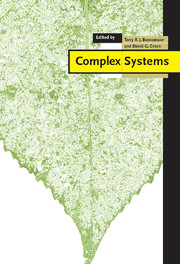Book contents
- Frontmatter
- Contents
- 1 Introduction
- 2 Self-organisation in complex systems
- 3 Network evolution and the emergence of structure
- 4 Artificial life: growing complex systems
- 5 Deterministic and random fractals
- 6 Non-linear dynamics
- 7 Non-linear control systems
- 8 Parallel computers and complex systems
- 9 Are ecosystems complex systems?
- 10 Complexity and neural networks
- Index
3 - Network evolution and the emergence of structure
Published online by Cambridge University Press: 04 August 2010
- Frontmatter
- Contents
- 1 Introduction
- 2 Self-organisation in complex systems
- 3 Network evolution and the emergence of structure
- 4 Artificial life: growing complex systems
- 5 Deterministic and random fractals
- 6 Non-linear dynamics
- 7 Non-linear control systems
- 8 Parallel computers and complex systems
- 9 Are ecosystems complex systems?
- 10 Complexity and neural networks
- Index
Summary
Introduction: networks of relationships are everywhere
We live in an ocean of networks. Both in our everyday lives with families or friends, and at work in a technological world, we are participating in various networks. And these networks are somehow reflections of our own bodies and minds.
When we rise in the morning we participate in the network of the family, a network which is a reverberation of our recent generations. When we shower and turn on the toaster we are utilising the provisions of electrical and water utilities which are themselves large networks. Turning on the radio on our trip to work, we are participants in a broadcast network connected by the electromagnetic spectrum, and the traffic network dynamically emerging as other citizens in our community engage in their business. Once at work, we may interact with the Internet with its diverse and always changing quilt of electronic communities. At times we may interact with different workgroups, and with our network of clients in the broader business or academic community. At lunch with a friend from our personal network, and after work with our tennis club, we continue to participate in various networks, variously overlapping in a greater whole.
Our bodies are a finely interwoven tapestry of many networks; the circulatory system providing nourishment to the vast network of body cells, the nervous system, the immune system, the lymphatic system and others subtly cooperating together in sustaining our lives.
- Type
- Chapter
- Information
- Complex Systems , pp. 51 - 90Publisher: Cambridge University PressPrint publication year: 2000
- 2
- Cited by



